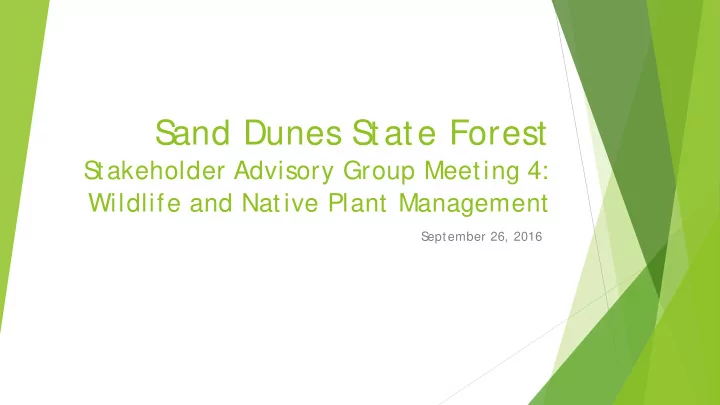

S and Dunes S tate Forest S takeholder Advisory Group Meeting 4: Wildlife and Native Plant Management S eptember 26, 2016
Things you care about… Camping Wildlife Aesthetic beauty Water quality Safety Biodiversity Recreational opportunities
Things you’re concerned about… Climate change Conversion Clearcutting Pesticides Poison Ivy Burning Fate of Trust Lands
DNR’s goal f for S r SDSF: Do right by the land • Protect rare and threatened native species • Provide sufficient habitat for all wildlife species • Harvest timber sustainably • Meet certification standards Do right by the people • Provide high quality recreation • Support local economy and the Permanent School Trust • Be a good neighbor …Now and in the Future
Managing f for t r the Future…. Pressures on Wildlife and Plant Communities in Sand Dunes SF: • Climate Change • Invasive Species • Growing population of Minnesotans • Habitat loss in other parts of the state Create Resiliency
Cl Climate C Cha hange Sand Dunes State Forest Trees – Response to Climate Change across the Entire Anoka Sand Plain Predicted change: Predicted change: Species name* low emissions scenario high emissions scenario Northern red oak Decrease Large Decrease Quaking aspen Large Decrease Large Decrease Bur oak No Change No Change American Elm Increase Increase Green ash No Change No Change No Change No Change Basswood Increase Large Decrease Black cherry Paper birch Large Decrease Large Decrease Northern pin oak Decrease Large Decrease Red pine** Large Decrease Decrease *Listed in order of abundance, relative to other Red maple Increase Increase tree species across the entire Anoka Sand Plain. Ironwood No Change No Change White oak Large Increase Increase **Not known to be native to the Sand Dunes Eastern red cedar State Forest; planted for timber (juniper) Large Increase Large Increase Jack pine** Increase Increase White pine** Increase Increase Source: US Forest Service Northern Research Big-toothed aspen No Change Large Decrease Station Climate Change Tree Atlas - Tamarack Increase Increase http://www.nrs.fs.fed.us/atlas/tree/ White spruce** Decrease No Change
2063 2016 wetland grass/brush wetland grass/brush open water open water 8% 8% 1% 1% wetland forest (ash and wetland forest (ash and tamarack) tamarack) 1% 1% non-oak dominated non-oak dominated forest (aspen or other forest (aspen or other hardwood) hardwood) 3% 3% plantation forests 40% oak woodland/forest plantation forests 21% 52% oak woodland/forest 22% savanna/prairie 26% savanna/prairie 13%
2063 2016 wetland grass/brush wetland grass/brush open water open water 8% 8% 1% 1% wetland forest (ash and wetland forest (ash and tamarack) tamarack) 1% 1% non-oak dominated non-oak dominated forest (aspen or other forest (aspen or other hardwood) hardwood) 3% 3% plantation forests 40% oak woodland/forest plantation forests 21% 52% oak woodland/forest 22% savanna/prairie 26% savanna/prairie 13%
Recommend
More recommend